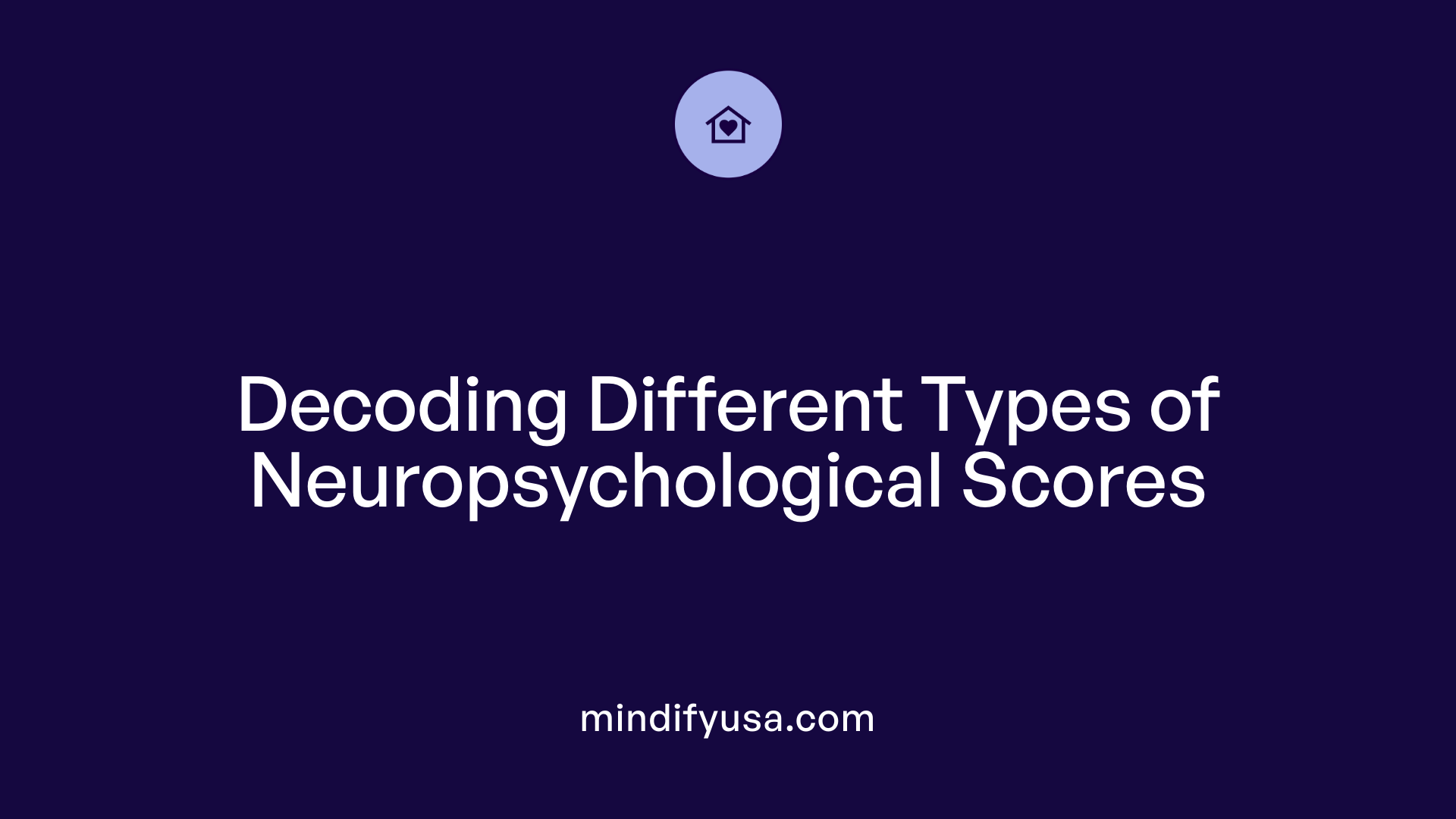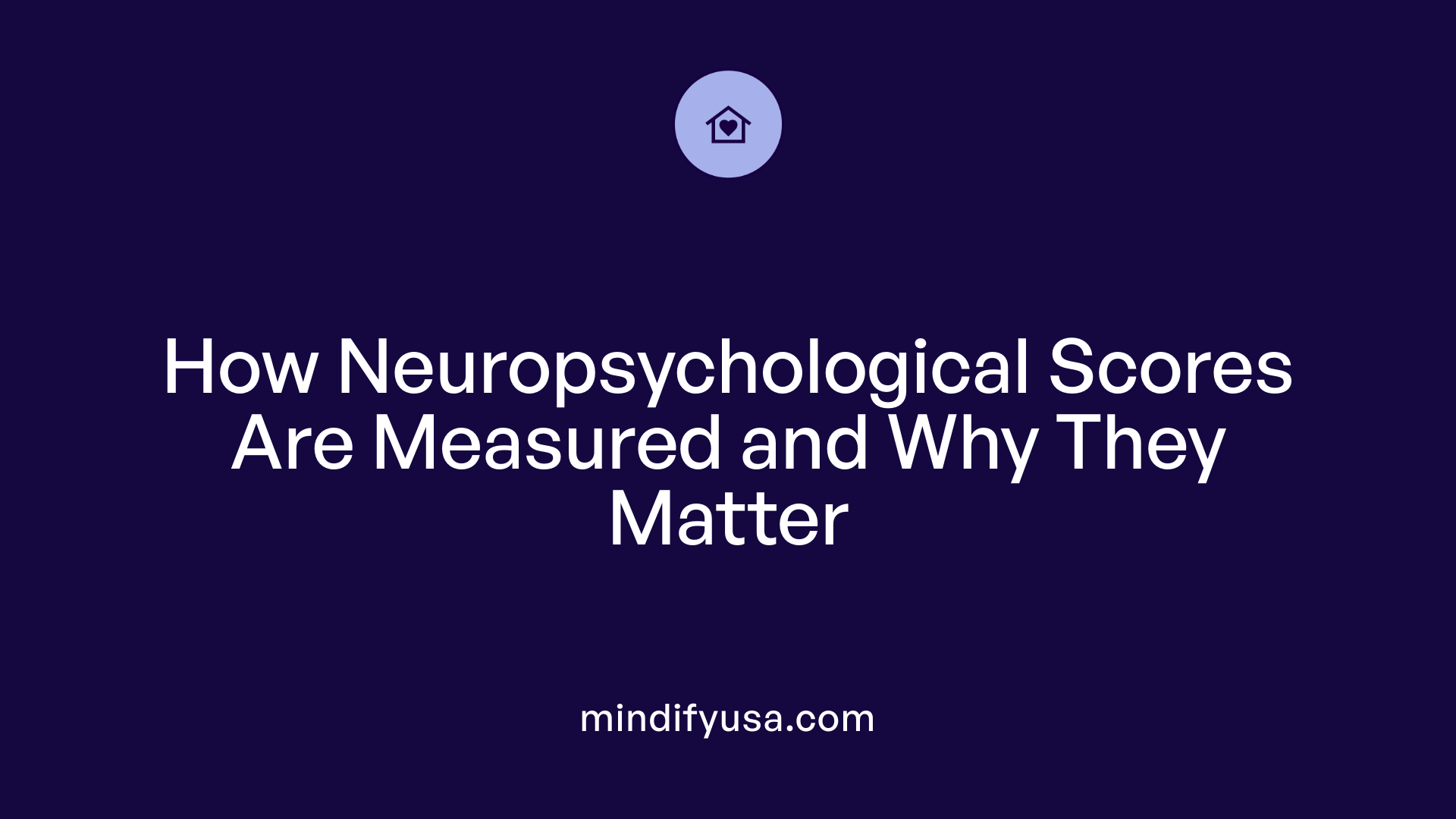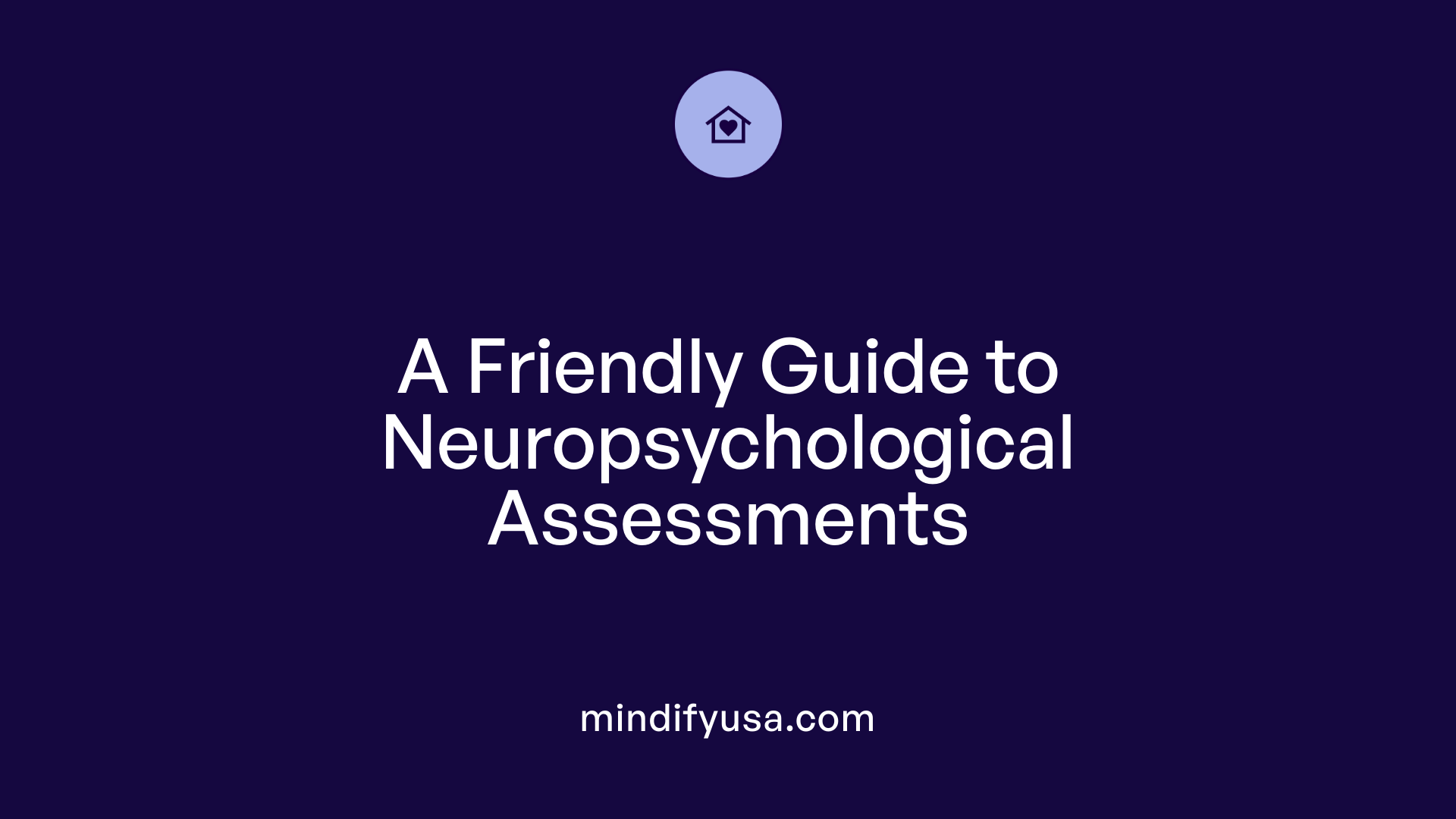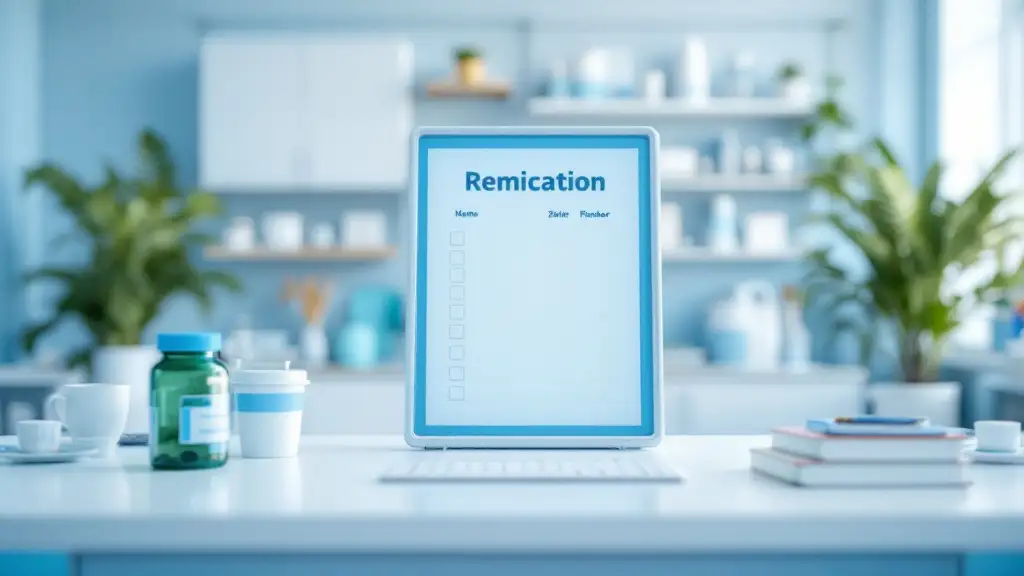Decoding Neuropsych Scores for Better Support
Neuropsychological assessments provide a detailed picture of how a child's brain functions across various cognitive, emotional, and behavioral domains. For parents, understanding what these scores mean can feel overwhelming, but it is essential for supporting their child's development and educational needs. This guide offers an in-depth explanation of common scoring methods, what the results reveal about a child's development, and how to interpret these scores in a clear, parent-friendly manner.
Types of Neuropsychological Scores and What They Represent

What do neuropsychological test scores mean for a child's development or diagnosis?
Neuropsychological assessment scores provide essential insights into a child's cognitive functioning. They compare a child's performance to that of peers of the same age, helping to identify strengths and areas needing support.
Standard scores typically have an average of 100, with deviations usually in steps of 10. For example, scores above 110 can indicate above-average functioning, while scores below 90 may suggest below-average performance.
Percentile scores show how a child's performance ranks compared to other children. For instance, a score at the 50th percentile means the child performed at the median level—right in the middle compared to their peers.
Scaled scores are mainly used for subtests within a larger battery. They have an average of 10 and a standard deviation of 3. Most children score between 7 and 13, placing them within one standard deviation of the mean.
T-scores, which are often used in behavioral assessments, have a mean of 50 and a standard deviation of 10. Scores over 60 might indicate areas of concern or heightened behavior that warrants further examination.
Interpreting these scores within the normal distribution (bell curve) helps professionals determine whether a child's abilities are within typical ranges or suggest potential difficulties. For example, a score of 70 or less on a standard score, which is three standard deviations below the mean, may signal significant challenges requiring intervention.
Most assessments include multiple score types to give a comprehensive picture. Standard scores and percentiles are particularly common and are crucial for diagnosing conditions, planning interventions, and tracking progress.
Understanding these scores helps parents and educators better grasp what a child's testing results mean for their development and how to support their learning journey.
How Scores Are Measured and Their Significance

What do neuropsychological test scoring results indicate about a child's development?
Neuropsychological test scores serve as a valuable window into a child's cognitive development. These scores—such as Standard, Percentile, Scaled, and T-scores—highlight specific strengths and weaknesses across various mental functions. For example, high scores in memory or language reveal areas of proficiency, while lower scores in attention or processing speed may point to challenges needing support.
Most scores are based on comparing a child's performance to typical development benchmarks derived from normative data. This data reflects how children of similar age and background perform, providing a standard for comparison.
Understanding Normative Data
Normative data creates a baseline of expected performance for children at each age. When a child's score falls within the average range—usually a Standard score between 90-109 or corresponding percentile around the 50th—they are considered to have typical development.
The Role of Standard Deviations
Scores are often expressed in terms of standard deviations (SD) from the mean. On a standard score with an average of 100, a score within one SD (85-115) is typical, representing about 68% of the population. Scores more than 2 SD below the mean (below approximately 70) can indicate significant difficulties, which may require intervention.
Range of Scores and Their Meaning
Scores can extend from very low to very high, illustrating the diversity in development. For example, a child's score of 130 or above (2 SD above the mean) suggests advanced skills, while a score below 70 indicates challenges that might affect daily functioning.
Interpreting Scores in Context
It is important to interpret these scores alongside other information, such as behavioral observations, medical history, and background. No score alone determines diagnosis; rather, it contributes to a comprehensive understanding of the child's profile.
Understanding these measures helps parents and professionals recognize typical development patterns, identify potential concerns, and plan appropriate educational or clinical interventions. Overall, test scores are essential tools for supporting children's growth and addressing their unique needs.
The Process of Neuropsychological Assessment in Child-Friendly Terms

What are the steps involved in a neuropsychological assessment?
The process begins with an initial review where the psychologist gathers background information about the child's medical history, school performance, and behavior. This is followed by several testing sessions, often spread over two half-days, where the child completes various activities designed to evaluate different brain functions.
During testing, the child might solve puzzles, answer questions, or complete hands-on tasks using paper, pencils, or computers. The aim is to see how well the child can think, remember, pay attention, and manage different skills.
Once testing is complete, the psychologist scores the results, which involves comparing the child's scores to those of other children their age. These scores are then interpreted to understand the child's strengths and areas that may need support.
The final step includes a feedback session with parents, where the psychologist explains the results in simple terms, discusses any diagnoses if applicable, and offers recommendations to help the child succeed at school and in daily life.
How are parents involved in the assessment?
Parents play a vital role throughout the process. Before testing begins, they provide important information about their child's development, behavior, and emotional well-being through questionnaires and interviews. This helps the psychologist understand the child's background.
During the assessment, parents may be asked to observe or provide additional insights about how their child behaves in different settings. After the testing, parents receive a detailed report that explains what the scores mean and how they relate to their child's learning and behavior.
Parents are encouraged to ask questions and discuss any concerns during the feedback session. The goal is to ensure parents feel informed and equipped with practical strategies or accommodations to support their child's growth.
What kinds of tests are used in a neuropsychological evaluation?
The assessment uses a variety of standardized tests tailored to the child's age and needs. Common tests measure areas such as:
- Intelligence and reasoning
- Academic skills like reading and math
- Attention and focus
- Memory and learning
- Language and communication
- Motor skills and visual-spatial abilities
- Emotional and behavioral functioning
Some of these tests produce scores called standard scores, scaled scores, or percentiles, which help compare the child's performance to that of peers. For example, a score of 100 on a standard score indicates average performance.
Why are clinical observations important?
In addition to tests, the psychologist observes how the child behaves during the assessment. These observations give clues about the child's behavior, motivation, and emotional state. For instance, they help determine if a child is anxious, distracted, or motivated, which can influence test performance.
By watching these behaviors, the psychologist can better interpret test results, understand the child's unique profile, and suggest appropriate interventions or accommodations.
| Aspect of Assessment | Typical Approach | Purpose | Further Notes |
|---|---|---|---|
| Assessment steps | Interviews, testing, scoring, feedback | To gather comprehensive understanding | Multiple sessions are usually involved |
| Parental involvement | Questionnaires, observations, feedback | To incorporate family's insights | Essential for a complete picture |
| Types of tests used | Cognitive, academic, behavioral | To evaluate various brain functions | Scores compare to normative data |
| Clinical observations | Observation during testing | To capture emotional and behavioral cues | Adds context to test scores |
This thorough and child-focused process helps parents understand why their child might face certain challenges and how to best support their development.
Interpreting Scores in Context
 Understanding the results of a neuropsychological assessment can seem complex at first glance. To begin, it's important to know that the scores generated from these tests are designed to compare your child's performance to that of peers their age, using standardized methods. Most often, results include standard scores and percentiles.
Understanding the results of a neuropsychological assessment can seem complex at first glance. To begin, it's important to know that the scores generated from these tests are designed to compare your child's performance to that of peers their age, using standardized methods. Most often, results include standard scores and percentiles.
Standard scores typically have an average of 100, with most scores falling within a range of 85 to 115, which is considered typical functioning. Scores below 70 may suggest significant difficulties, while scores above 115 might reflect above-average abilities. Percentile scores reveal how a child stacks up against others; for example, a 50th percentile indicates performance around the median, or the middle of the distribution.
These scores are derived from tests assessing various areas such as memory, language, attention, mathematical reasoning, and processing speed. While they provide a useful overview, scores should not be viewed in isolation. An important part of interpreting results involves seeing how a child's strengths and weaknesses align across different domains.
Behavioral observations made during testing, along with background information provided by parents and teachers, add critical context. For instance, a child's effort, emotional state, or fatigue during testing can influence scores. Similarly, environmental influences like home support, educational environment, or recent life changes can impact performance.
Because scores may sometimes fall outside the typical range, they should be weighed alongside behavioral observations and background details. This comprehensive approach helps to distinguish between genuine difficulties and factors like test anxiety or temporary setbacks.
Consulting a psychologist is vital. These professionals can synthesize test results, behavioral data, and background information to produce an accurate interpretation. They can help you understand what the scores mean for your child's development and recommend appropriate interventions or supports.
In summary, neuropsychological scores are valuable tools that, when considered within the full context, offer meaningful insights into your child's cognitive and emotional functioning, guiding tailored strategies to support their growth.
Making Sense of the Results: A Parent’s Role in Supporting Development

What do neuropsychological test scores mean for a child's development or diagnosis?
Neuropsychological assessment scores offer a window into a child's cognitive landscape. These scores compare performance to that of other children of similar age, illustrating where your child stands in various areas such as memory, language, problem-solving, and attention.
Standard scores, with an average of 100, and percentiles, which show a child's rank compared to peers, help identify strengths and weaknesses. For example, a child scoring in the lower percentiles may face particular challenges that warrant further support.
Most scores, such as scaled scores and T-scores, are grounded in the normal distribution, or bell curve, which describes how most people score around the average. Scores falling significantly below average, for instance more than 3 standard deviations below the mean, can signal the need for targeted interventions.
By interpreting these scores alongside clinical observations and background information, professionals can provide insights into a child's development. This understanding is essential for diagnostics, planning educational strategies, and tracking progress. For parents, this means that the numbers are more than just data; they are clues that help shape effective support systems.
How do strengths and weaknesses highlighted by assessment influence educational planning?
When a neuropsychological evaluation identifies specific areas of strength, such as exceptional verbal reasoning, and weaknesses, like difficulties with visual-spatial tasks, educators can tailor learning methods to better suit the child's needs.
For example, a child with below-average processing speed may benefit from extended test-taking time or modified assignments. Conversely, recognizing strong memory skills can help leverage that ability in other learning areas.
These insights inform the creation of individualized education plans (IEPs), which aim to provide the most effective educational environment for your child's success. They also guide classroom accommodations, therapy goals, and support services.
Furthermore, understanding a child's unique cognitive profile fosters a collaborative approach between parents, teachers, and specialists, ensuring consistent support at home and school.
A quick look at how scores relate to support and development
| Score Type | Typical Range | What It Indicates | Use in Planning |
|---|---|---|---|
| Standard scores | Around 100 (Average of 100) | Developmental status, cognitive strengths or weaknesses | Diagnosis, intervention, educational adjustments |
| Percentiles | 1-99 | Relative comparison to peers | Highlighting areas needing support |
| Scaled scores | 1-19, mean of 10 | Subtest-specific skills, e.g., language, attention | Targeted skill improvement |
| T-scores | Mean of 50, above 60 may be concerning | Behavioral and emotional functioning | Behavioral interventions, emotional support |
Supporting Your Child Based on Assessment Findings
Understanding scores empowers you to advocate effectively for your child's needs. Engaging with professionals to clarify what the results mean will help you make informed decisions, from classroom accommodations to therapy options.
Monitoring changes over time through follow-up assessments can also illustrate progress or the need for adjustments in support strategies. Remember, these scores are a guide—your child's unique strengths, interests, and personality are equally vital in shaping their developmental journey.
Summary and Practical Recommendations Based on Scores
 Creating personalized support strategies begins with understanding the neuropsychological test scores. These scores provide a detailed profile of a child's cognitive strengths and challenges, which can help tailor educational and developmental support plans.
Creating personalized support strategies begins with understanding the neuropsychological test scores. These scores provide a detailed profile of a child's cognitive strengths and challenges, which can help tailor educational and developmental support plans.
Parents and educators can use the scores to develop targeted interventions and accommodations. For example, if a child scores low in processing speed or memory, specific strategies like extra time on tests, note-taking aids, or structured routines can be beneficial.
Educational settings can implement accommodations such as preferential seating, visual aids, or assistive technology. These adjustments help maximize the child's learning potential and reduce frustration.
Interventions may include specialized tutoring, behavioral therapy, or occupational therapy, depending on the areas where the child shows difficulties. For instance, a child with executive functioning challenges might benefit from organizational training or planning tools.
| Score Type | What It Measures | Typical Range | Implication for Support |
|---|---|---|---|
| Standard Score | General cognitive ability | 85-115 (average), above 115, below 85 | Guides overall educational planning |
| Percentile | Performance compared to peers | 1st-99th percentile | Highlights relative strengths or weaknesses |
| Scaled Score | Subtest performance | 7-13 (average) | Fine-tunes understanding of specific skills |
| T-Score | Behavioral and emotional regulation | Over 60 may indicate concern | Directs behavioral or emotional interventions |
Understanding these scores is crucial for effective planning. Most reports include a summary and recommendations tailored to the child's unique profile.
How can parents understand the results of a neuropsychological assessment? To comprehend these results, parents should review the report thoroughly and discuss it with a qualified professional, such as a neuropsychologist. The professional can clarify what the various scores mean in relation to their child's cognitive and emotional functioning. It is important to learn the difference between score types—standard scores (average of 100), percentiles (how performance compares to others), scaled scores, and T-scores—and how these relate to their child's performance.
The report will identify areas of strength and weakness, providing valuable insights into their child's learning style and potential hurdles. Non-cognitive influences, such as effort, mood, or fatigue, can affect test outcomes, so discussing these factors with the professional is essential.
Ultimately, understanding assessment scores is a collaborative effort aimed at translating detailed data into effective strategies. These insights enable parents and educators to create tailored support plans, adjust teaching methods, and introduce interventions that foster the child's development and learning success.
The Role of a Pediatric Neuropsychologist and Resources Available

What are the qualifications of neuropsychologists?
Pediatric neuropsychologists typically hold a doctoral degree such as a Ph.D. or Psy.D. in psychology, with specialized training in neuropsychology through internships and post-doctoral programs. They also complete extensive supervised clinical work focused on brain-behavior relationships, enabling them to accurately interpret complex test results. These professionals are skilled in administering standardized assessments, observing behaviors, and providing detailed analysis of a child's cognitive and emotional functioning.
Where can assessments be obtained, and how do they help?
Referrals for neuropsychological assessments often come from parents, schools, or healthcare providers. These evaluations take place in various settings including hospitals, outpatient clinics, private practices, and university centers. An example is the UNM Center for Neuropsychological Services, which offers specialized testing.
The comprehensive reports generated from these assessments include an overview of the child's strengths and challenges, interpretations of test scores, diagnostic impressions, and personalized recommendations. These insights are crucial for developing effective educational strategies, securing accommodations like IEPs, and guiding intervention plans. Through precise measurement of cognitive skills such as memory, attention, language, and executive functioning, neuropsychologists help identify underlying issues that affect learning and behavior.
What do report sections include?
A detailed neuropsychological evaluation report generally comprises several key sections:
| Section | Contents | Purpose |
|---|---|---|
| Reason for Referral | Background and presenting concerns | Context for assessment |
| Assessments Administered | Tests used for evaluation | Scope of evaluation |
| Background Information | Medical, developmental, educational history | Understanding individual context |
| Behavioral Observations | Behavior during testing | Insights into emotional and behavioral state |
| Assessment Results & Interpretations | Test scores and analysis | Identify strengths and weaknesses |
| Summary & Impressions | Overall findings and diagnoses | Clarify the child's profile |
| Recommendations | Educational, therapeutic, behavioral suggestions | Guide for intervention |
How do assessments impact educational planning?
Results from neuropsychological evaluations are vital in shaping a child's educational experience. They help pinpoint specific learning disabilities, cognitive delays, or strengths that can be addressed through targeted interventions.
By understanding a child's unique brain profile, educators and support teams can develop individualized education plans (IEPs), set realistic goals, and implement accommodations that support learning. These may include extra time for tests, modified assignments, or social-emotional interventions. Ultimately, this process aims to improve academic achievement, social skills, and overall well-being.
| Function | Example | Benefit |
|---|---|---|
| Diagnostic Clarity | Differentiating ADHD from other conditions | Tailored treatment plans |
| Educational Support | Adjusted teaching strategies | Improved learning outcomes |
| Behavioral Interventions | Social skills training | Better classroom behavior |
| Medical Recommendations | Medication, therapy | Comprehensive support |
Understanding how neuropsychological scores relate to real-world functioning helps families and professionals make informed decisions and foster a supportive environment for children with diverse needs.
Empowering Parents with Knowledge
Understanding your child's neuropsychological scores is a vital step in supporting their development, education, and emotional well-being. By becoming familiar with the types of scores, what they reveal about your child's strengths and challenges, and how to interpret them in context, parents can advocate more effectively for their child's needs. Remember, working closely with qualified professionals and keeping an open line of communication ensures that these results translate into meaningful support and positive outcomes. With the right understanding, you can help your child thrive and reach their full potential.
References
- Explanation of test scores for Parents
- How to Interpret Neuropsychological Test Results
- Interpreting Results from a Neuropsychological Testing ...
- Parent's Guide to the Pediatric Neuropsychological ...
- How to Read a Neuropsychological Evaluation Report
- Pediatric neuropsychology - Parent guide - NCNF
- How to Understand a Neuropsychological Report
- A Parent's Guide to Pediatric Neuropsychological ...





































































































